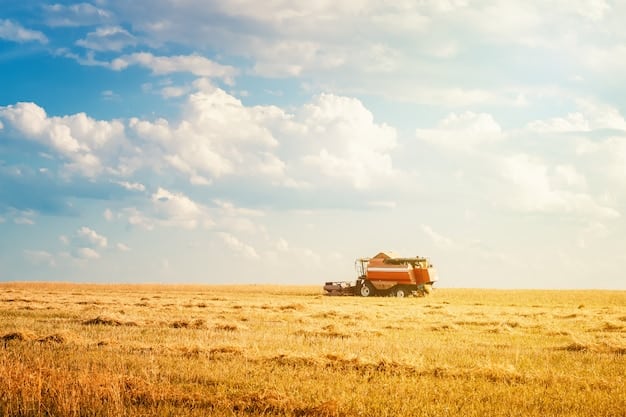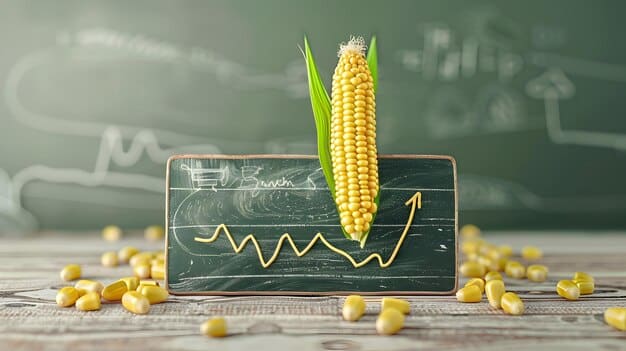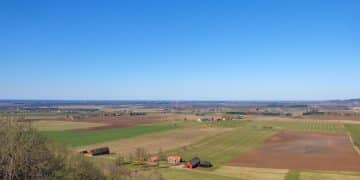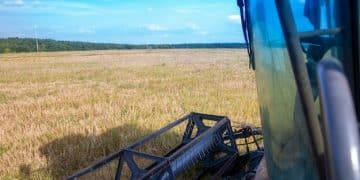US Farmland Rental Rates: Projecting a 2% Increase in 2025?

US farmland rental rates are projected to increase by 2% in 2025, driven by factors such as strong commodity prices, limited land availability, and rising input costs; understanding these factors is crucial for farmers and landowners alike for strategic financial planning.
The agricultural landscape is ever-changing, and understanding market trends is crucial for farmers, landowners, and investors. A projection indicates that US farmland rental rates are expected to climb by 2% in 2025, prompting stakeholders across the nation to examine the underlying causes and potential impacts of this shift.
Understanding the Projected Increase in US Farmland Rental Rates
The forecast of a 2% rise in farmland rental rates across the United States for 2025 has captured the attention of the agricultural community. This projected increase isn’t arbitrary; it’s rooted in a combination of economic, environmental, and market-related factors that collectively influence the cost of renting agricultural land.
Understanding the dynamics at play will enable better decision-making and strategic planning for those involved. Let’s delve into the key drivers behind this anticipation and why it matters for the US agricultural sector.
The Role of Commodity Prices
Commodity prices significantly impact the profitability of farming operations, influencing the ability of farmers to afford higher rental rates. When prices for crops like corn, soybeans, and wheat are high, farmers are generally more willing to invest in land rentals, driving up demand and, consequently, rates.
- Increased revenue: Higher commodity prices mean increased potential revenue for farmers, making rental payments more manageable.
- Competitive bidding: Elevated prices can lead to competitive bidding among farmers for available land, pushing rental rates upward.
- Investment incentives: Higher returns incentivize investment in better farming practices and technology, further supporting the ability to pay more for land.

In conclusion, the price of agricultural commodities is a key factor influencing farmers’ willingness and capacity to pay for land, driving the projected increase in rental rates. Monitoring these prices is an important part of understanding market trends and economic forces on farmland.
The Impact of Limited Farmland Availability
The amount of available farmland in the US is not limitless, and in many regions, it’s becoming increasingly scarce. This scarcity is due to various factors, including urban development, environmental conservation efforts, and the conversion of agricultural land to other uses.
When the supply of farmland is restricted and demand continues to grow, the rental rates naturally escalate. Let’s examine how this shortage affects rental prices.
Urban Expansion and Development
As cities and suburbs expand, agricultural land on the outskirts is often converted into residential, commercial, or industrial properties. This conversion reduces the amount of land available for farming, particularly in densely populated areas.
- Reduced acreage: Urban sprawl diminishes the total acreage of farmland, intensifying competition for the remaining parcels.
- Increased value: Land near urban centers becomes more valuable for development, incentivizing landowners to sell rather than rent for agricultural use.
- Higher taxes: Increased property values can lead to higher taxes on farmland, making it more expensive to hold and potentially driving up rental rates to offset these costs.
Limited availability of farmland, driven by urban expansion, exerts upward pressure on rental rates, as farmers compete for fewer available acres. This highlights the importance of land preservation efforts to maintain the viability of agricultural operations.
Rising Input Costs: A Decisive Factor
Farmers face a multitude of expenses when planting and harvesting. These include the costs of seeds, fertilizers, pesticides, machinery, fuel, and labor. Sharp increases in any of these inputs can significantly impact a farmer’s profitability and influence their capacity to afford rents.
Several variables relating to these escalating expenses result in increased farmland rental rates, which will be discussed in detail below.
Fertilizer and Chemical Prices
Fertilizers and chemicals are essential for crop production, ensuring optimal yields and preventing losses due to pests and diseases. However, these inputs can be costly, and price fluctuations can have a major impact on farming operations.
- Supply chain disruptions: Global events, trade policies, and transportation issues often disrupt the supply chain, leading to scarcity and higher prices for fertilizers and chemicals.
- Energy costs: The production of fertilizers and chemicals is energy-intensive, meaning that increases in energy prices directly translate to higher production costs.
- Environmental regulations: Stricter environmental regulations can increase the cost of producing and using certain fertilizers and chemicals, prompting higher prices.
The rising costs of fertilizers and chemicals create additional financial pressures for farmers, influencing their willingness or ability to pay higher rents. Farmers must thus consider the economic implications of these factors when deciding whether to plant.
Economic Conditions and Inflationary Pressures
The overall economic climate plays a significant role in shaping farmland rental rates. Factors such as inflation, interest rates, and the strength of the US dollar can all have profound effects on the agricultural sector.
Underlying economic conditions set the stage for projected increases in farmland rental rates. Here’s how inflationary pressure affects the rates.
Inflation and Its Effects
Inflation erodes the purchasing power of money, increasing the cost of goods and services across the economy. In the agricultural sector, inflation can drive up the cost of inputs, labor, and other operating expenses.
As a result of inflation, the agricultural industry has had to adjust. The following are some ways inflation impacts the agriculture sector:
- Increased Input Costs: The cost of farming inputs such as fertilizers, pesticides, fuel, machinery, and labor escalates significantly due to inflation.
- Reduced Profit Margins for Farmers: Farmers face challenges in maintaining profit margins as they struggle to pass on the increased input costs to consumers.
- Land values and rental rates: Historically, farmland has been considered an inflation hedge.
Interest Rates and Financing
Interest rates influence the cost of borrowing money, affecting farmers’ ability to finance their operations and make investments in land. When interest rates rise, it becomes more expensive for farmers to secure loans, which can impact their ability to pay higher rental rates.
In conclusion, economic factors such as inflation, interest rates, and currency fluctuations contribute to the overall financial climate in which farmland rental rates are determined. Monitoring these factors is very important for stakeholders in the agricultural sector.

Regional Variations in Rental Rate Increases
While a 2% increase in farmland rental rates is projected nationally, it is essential to recognize that the actual change can vary significantly from one region to another. Local factors, such as soil quality, climate, water availability, crop suitability, and market access, all play a role in determining rental rates.
Regional disparities are common in US agricultural markets. We will discuss how geography can influence projected rental prices.
The Midwest Region
The Midwest is the heartland of US agriculture, known for its fertile soils and favorable climate for growing corn, soybeans, and other crops. Rental rates in this region are generally among the highest in the country, reflecting the high productivity and profitability of farming operations.
- High productivity: Fertile soils and reliable rainfall in the Midwest result in high crop yields, supporting higher rental rates.
- Strong demand: The Midwest is a prime agricultural region, attracting farmers from across the country and driving up demand for farmland.
- Infrastructure: Well-developed transportation and processing infrastructure in the Midwest facilitate the efficient movement of crops to market.
In summary, rental rate increases are expected to be most pronounced in regions with high productivity, strong demand from farmers, and well-developed agricultural infrastructure. Understanding these regional variations is vital for making informed decisions. The expected price increase will be impacted regional economical variations.
Strategies for Farmers and Landowners
In light of the projected increase in US farmland rental rates for 2025, both farmers and landowners need to adopt proactive strategies to navigate the changing market conditions. For farmers, this means finding ways to enhance efficiency, optimize input usage, and manage risk effectively. For landowners, it involves understanding the true value of their land, diversifying income streams, and fostering long-term relationships with tenants.
Farmers and landowners can implement new practices to mitigate risks associate with projected rental rate increases. Here’s how:
For Farmers: Enhancing Efficiency and Managing Costs
With rental rates on the rise, farmers must prioritize efficiency improvements and cost-cutting measures to maintain profitability. This involves optimizing input usage, adopting precision farming techniques, and seeking out new technologies that can boost yields and reduce waste.
- Precision farming: Using GPS, sensors, and data analytics to precisely apply inputs (fertilizers, pesticides, water) only where needed can reduce costs and minimize environmental impact.
- Crop diversification: Planting a variety of crops can reduce reliance on a single commodity and provide a hedge against price fluctuations.
- Negotiate rental agreements: Explore options for flexible rental agreements that tie rental rates to crop prices or yields, providing shared risk and reward between farmers and landowners.
In conclusion, proactive strategies and careful planning can help farmers and landowners navigate the challenges and opportunities presented by the projected increases in farmland rental rates. Managing risk, diversifying income streams, and fostering collaborative partnerships will be essential for long-term success.
| Key Aspect | Brief Description |
|---|---|
| 📈 Commodity Prices | Higher prices increase farmer’s revenue, driving up rental demand. |
| 🏘️ Urban Expansion | Reduces farmland availability, intensifying competition for remaining land. |
| 💲 Rising Input Costs | Increased fertilizer and chemical prices pressure farmers’ finances. |
| 🌎 Regional Variances | Rental rates vary regionally due to soil quality, climate, and market access. |
Frequently Asked Questions
▼
The projected increase is mainly due to higher commodity prices, limiting the amount of available land, and rising input costs. All of these factors combine to make land more in demand, and therefore, more expensive.
▼
When commodity prices are high, farmers earn more, increasing their willingness to pay higher rental rates. This drives up demand for farmland, resulting in increased rates. Higher commodity prices directly translate to farmers being more willing to pay more.
▼
As urban development and other factors reduce available farmland, competition increases. Landowners are able to push higher rates due to scarcity. This pushes rates up because the same number of farmers are fighting over fewer available units of land.
▼
Rising input costs put a financial squeeze on the farmer. Farmers need to produce as much value as possible from their crops, including paying more for quality land to maximize production.
▼
Yes, regional differences exist due to variances in soil quality, climate, market access, and other localized conditions. The Midwest, for instance, often experiences higher increases due to its fertile soil and prime position in the agricultural market.
Conclusion
The projected 2% increase in US farmland rental rates for 2025 reflects the convergence of multiple economic and environmental dynamics. Elevated commodity prices, limited land availability, and rising input costs all play a role in shaping the agricultural landscape. Farmers and landowners who proactively adapt to these market trends through strategic planning and innovative practices will be best positioned for long-term success.





